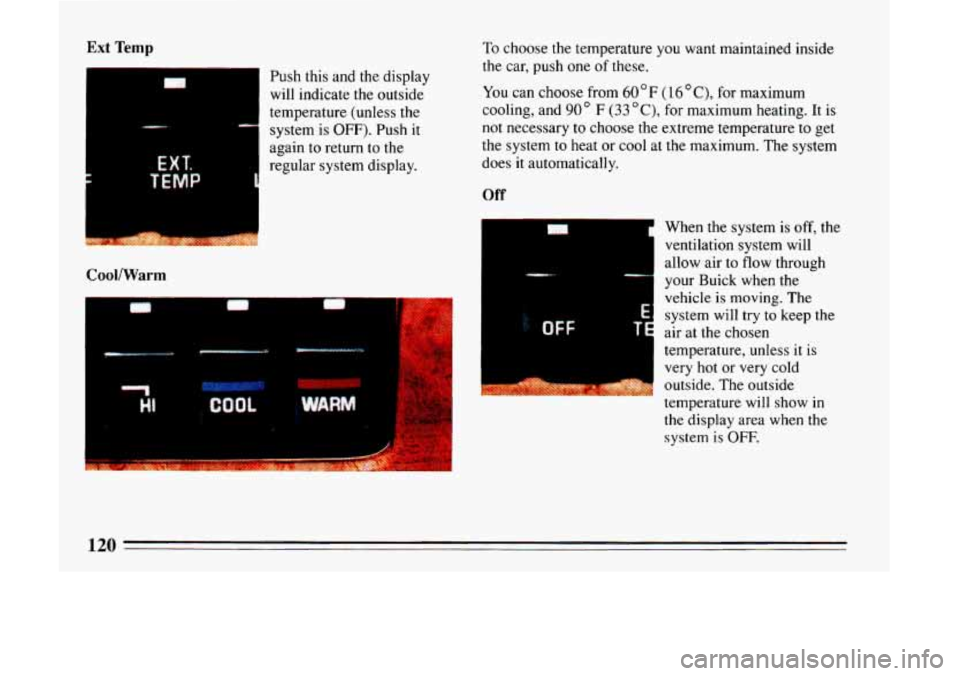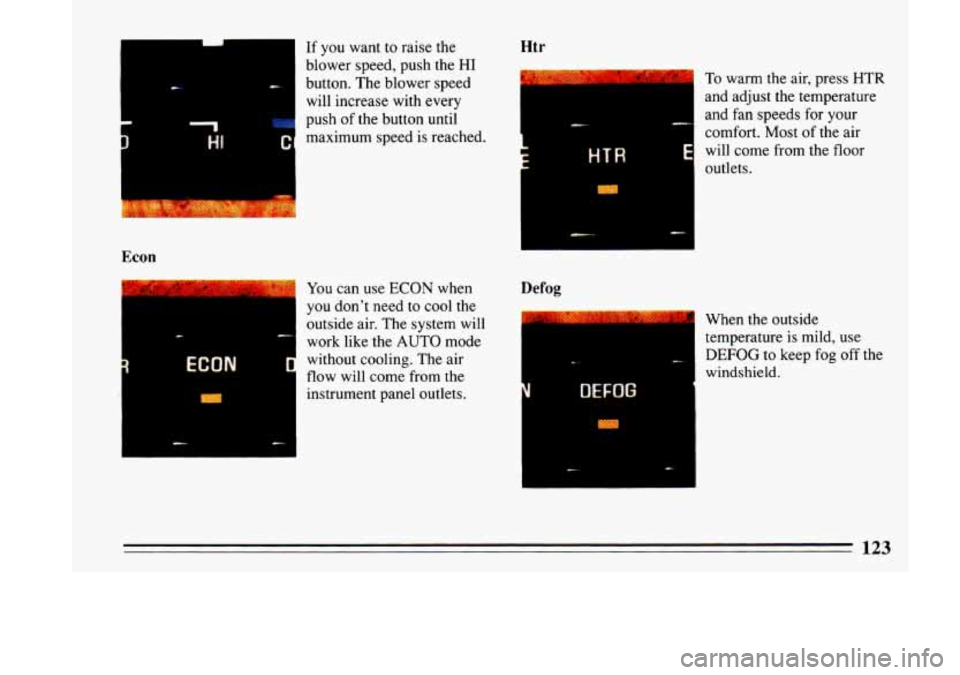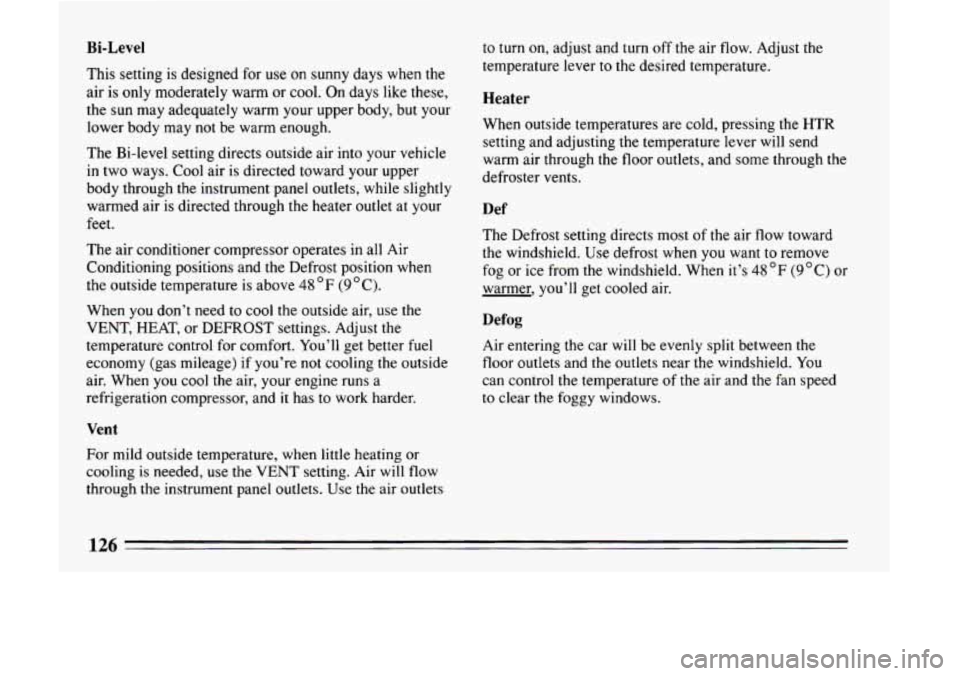1993 BUICK LESABRE cooling
[x] Cancel search: coolingPage 112 of 324

/I CAUTION:
If you let your tires spin at high speed when the
“TRACTION OFF“ warning light is on, they can
explode and you or others could be injured. And,
spinning your tires with the “TRACTION OFF”
warning light on can cause the transaxle to
overheat
or can cause other problems. That
could
cause an engine fire or other damage.
When you’re stuck,
spin the wheels as little as
possible. Don’t spin the wheels above 35 mph
(55 km/hl as shown on the speedometer.
I
:’NOTICE:
Spinning your wheels whel. ..?e “Tl .A (ION
OFF” warning light is on can destroy parts 01
your vehicle as well as the tires. If you spin your
wheels too fast while shifting your transaxle
back and forth, you can destroy your transaxle.
rheel!
s little B
I
When yor-’-e stud
possible. bin
Engine Coolant
Temperature Warning
Light
TEMP
This light tells you that your engine coolant has
overheated or your radiator cooling fans are
not
working. If you have been operating your vehicle under
normal driving conditions, you should
pull off the road,
stop your vehicle and turn the engine
off as soon as
possible.
HOT COOLANT CAN BURN YOU BADLY!
In “Problems on the Road,” this manual shows what to
do. See “Engine Overheating”
in the Index.
Page 122 of 324

Ext Temp
Push this and the display
will indicate the outside
temperature (unless
the
system is OFF). Push it
again to return to the
regular system display.
D D
EXT.
TEMP
CoollWarm
To choose the temperature you want maintained inside
the car, push one of these.
You can choose from
60°F (16OC), for maximum
cooling, and
90 F (33 "C), for maximum heating. It is
not necessary to choose the extreme temperature to get
the system to heat
or cool at the maximum. The system
does it automatically.
Off
T 7
When the system is off, the
ventilation system will
allow air to flow through
your Buick when
the
vehicle is moving. The
system will try
to keep the
air at the chosen
temperature, unless it is
very hot
or very cold
outside. The outside
temperature will show in
the display area when the
system is
OFF.
120
Page 125 of 324

c
L I
If you want to raise the
blower speed, push the
HI
button. The blower speed
will increase with every
push
of the button until I I maximum speed is reached.
Econ
ECON r
You can use ECON when
you don’t need to cool the
outside air. The system will
work like the
AUTO mode
without cooling. The air
Ht r
1
To warm the air, press HTR
and adjust the temperature
and
fan speeds for your
comfort. Most of the air
will come from the floor
HTR E
outlets.
Defog
When the outside
temperature is mild, use
DEFOG to keep fog off the
windshield.
Page 127 of 324

If your Buick has this climate control system, the
following information tells you how it works.
Your Buick's flow through ventilation system supplies
outside air into
the vehicle when it is moving. When the
heater or air conditioning fan is running, outside air
will
also enter the vehicle.
Fan Speeds
The fan control is used to select the speed you want the
blower to control the air flow.
Lever Controls
The upper lever changes the fan speeds. The lower lever
changes the temperature
of the air coming through your
air outlets.
Air Conditioning
The next three selections cool the air. The air
conditioner won't work well unless all the windows are
closed. On very hot days, open the windows long
enough
to let hot inside air out. This reduces the amount
of work your air conditioner's compressor will have to
do, which should help fuel economy.
Max
This setting provides maximum cooling with the least
amount of work.
MAX recirculates much of the air
inside your vehicle
so it maximizes your air
conditioner's performance and fuel economy.
Norm
Use NORM for normal cooling on hot days. This setting
cools outside air and directs it through the instrument
panel outlets.
125
Page 128 of 324

Bi-Level
This setting is designed for use on sunny days when the
air is only moderately warm or
cool. On days like these,
the sun may adequately warm your upper body, but your
lower body may
not be warm enough.
The Bi-level setting directs outside air into your vehicle
in two ways. Cool air is directed toward your upper
body through the instrument panel outlets, while slightly
warmed air is directed through the heater outlet at your
feet.
The air conditioner compressor operates in all Air
Conditioning positions and the Defrost position when
the outside temperature is above
48 OF (9OC).
When you don’t need to cool the outside air, use the
VENT, HEAT, or DEFROST settings. Adjust the
temperature control for comfort. You’ll get better fuel
economy (gas mileage) if you’re
not cooling the outside
air. When
you cool the air, your engine runs a
refrigeration compressor, and it has to work harder.
Vent
For mild outside temperature, when little heating or
cooling is needed, use the
VENT setting. Air will flow
through the instrument panel outlets. Use
the air outlets to
turn on, adjust and turn
off the air flow. Adjust the
temperature lever to the desired temperature.
Heater
When outside temperatures are cold, pressing the HTR
setting and adjusting the temperature lever
will send
warm air through the floor outlets, and some through the
defroster vents.
Def
The Defrost setting directs most of the air flow toward
the windshield. Use defrost when
you want to remove
fog or ice from
the windshield. When it’s 48 OF (9 “C) or
warmer, you’ll get cooled air.
Defog
Air entering the car will be evenly split between the
floor outlets and the outlets near the windshield. You
can control the temperature of the air and the fan speed
to clear the foggy windows.
126
Page 182 of 324

Hill and Mountain Roads
-.
Driving on steep hills or mountains is different from
driving in flat or rolling terrain.
If you drive regularly in steep country, or if you're
planning to visit there, here are
some tips that can make
your trips safer and
more enjoyable.
0 Keep your vehicle in good shape. Check all fluid
levels and also the brakes, tires, cooling system and
transaxle. These parts can work hard
on mountain
roads.
Know how to go down hills. The most important
thing
to know is this: let your engine do some of the
slowing down. Don't make your brakes do it all.
Shift
to a lower gear when you go down a steep or
long hill. That way, you will slow down without
excessive use of your brakes.
A CAUTION:
If you don't shift down, your brakes could get so
hot that they wouldn't work well. You would then
have poor braking
or even none going down a
hill. You could crash. Shift down to let your
engine assist your brakes on
a steep downhill
slope.
180
Page 196 of 324

Parking on Hills
You really should not park your vehicle, with a trailer
attached, on a hill. If something goes wrong, your rig
could start to move. People can be injured, and both
your vehicle and the trailer can be damaged.
But if you
ever have to park your rig on a hill, here’s
how to do it:
1. Apply your regular brakes, but don’t shift into “P7’
(Park) yet.
2. Have someone place chocks under the trailer wheels.
3. When the wheel chocks are in place, release the
regular brakes until the chocks absorb the load.
4. Reapply the regular brakes. Then apply your parking
brake, and then shift to
“P” (Park).
5. Release the regular brakes.
When You Are Ready to Leave After
Parking
on a Hill
1. Apply your regular brakes and hold the pedal down
while you:
Start your engine;
Shift into a gear; and
0 Release the parking brake.
2. Let up on the brake pedal.
3. Drive slowly until the trailer is clear of the chocks.
4. Stop and have someone pick up and store the chocks.
Maintenance When Trailer Towing
Your vehicle will need service more often when you’re
pulling a trailer. See the Maintenance Schedule for more
on this. Things that are especially important in trailer
operation are automatic transaxle fluid (don’t overfill),
engine oil, belts, cooling system, and brake adjustment.
Each of these is covered
in this manual, and the Index
will help you find them quickly. If you’re trailering, it’s
a good idea to review these sections before you
start
your trip.
Check periodically to see that all hitch nuts and bolts are
tight.
194
Page 212 of 324

0 -' e
A! ek-bic fan under the kod-can start up even
when' the endne is not runniiig and can Injure
yoG. Keep hands, clothing and tools away from
any underhood electric fan.
I
If the coolant inside the coolant recovery tank is boiling,
don't do anything else until it cools down.
I-
rs-
L
I
P
The coolant level should be at or above "FULL COLD.''
If it isn't, you may have a leak in the radiator hoses,
heater hoses, radiator, water
pump or somewhere else in
the cooling system,
I
/A CAUTION: 0
Heater and radiator hoses, and other engine
parts, can be very
hot. Don't touch them. If you p
do, you can be burned.
Don't run the engine if there is a leak.
If you run
the engine,
it could lose all coolant. That could
cause an engine fire, and you could be burned.
Get any leak fixed before you drive the vehicle.
I
Engine damage from running your engine
without coolant isn't covered by your warranty.
If there seems to be no leak, check to see if the electric
engine fans are running.
If the engine is overheating,
both fans
should be running. If they aren't, your vehicle
needs service.